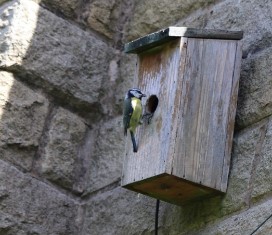 A Blue Tit entering a nesting box to feed fledglings.
A Blue Tit entering a nesting box to feed fledglings.
In November 2017, DEFRA (Department for Environment, Food and Rural Affairs) completed a report on bird populations. It showed a range of declines, particularly in populations of farmland birds, seabirds and woodland birds between 1970 and 2016. As we have monitored birds for a long period of time, there is longer term data available compared to other animals. This allows us to consider population change over time. Due to their position in the food chain (they eat insects), birds are also a useful indicator on the fitness of the environment.
The shortage of nesting sites for birds has played at least a part in the decline of some of the UK’s bird species. Natural nesting sites disappear as gardens are ‘tidied up’ and so old trees with nesting holes disappear, and old houses and barns are repaired and upgraded. Fortunately, it is relatively easy to help correct this by providing nesting opportunities for birds in our gardens and other outdoor spaces.
How can you help birds’ nest in your garden?
When?
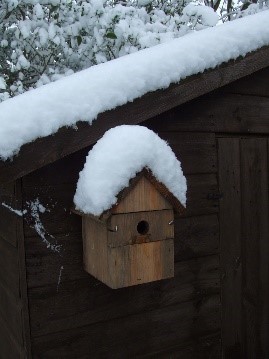 You can put up a nesting box at any time of the year. If possible, you should keep your bird boxes up all year round which will give your garden birds the chance to get used to them. Indeed, even when boxes are not being used for nesting, egg laying and as a home for fledglings, they can provide somewhere for birds to roost. They provide shelter from bad weather - rain, snow, wind and cold, as shown in the image to the right.
You can put up a nesting box at any time of the year. If possible, you should keep your bird boxes up all year round which will give your garden birds the chance to get used to them. Indeed, even when boxes are not being used for nesting, egg laying and as a home for fledglings, they can provide somewhere for birds to roost. They provide shelter from bad weather - rain, snow, wind and cold, as shown in the image to the right.
Where?
It is important to select the ideal location in your garden for a bird box. Birds are much more likely to make use of your nesting box if you select the right location. That is a location that is both relatively safe and has the right temperature.
You can locate the box on a tree or wall of your home or other building in your garden. Make sure it is at least one metre above the ground, and ideally no higher than five metres. Different birds prefer different heights.
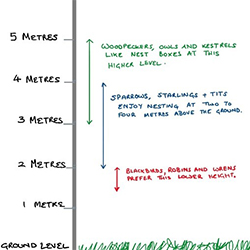 The other important element to think about is the temperature. Whilst we may be happy to sit in the warmest part of the garden the same isn’t true for where nesting boxes should be located.
The other important element to think about is the temperature. Whilst we may be happy to sit in the warmest part of the garden the same isn’t true for where nesting boxes should be located.
As such make sure that you do not locate the bird box on a south facing wall. This is to avoid the young birds becoming too hot and having to utilise their energy to cool down rather than expending energy on growth. To keep the nesting box at the right temperature place it in a north or east facing position. This avoids excessive heat and can also help in keeping out the wind.
To reduce the rain impact, make sure it is tilted forward slightly when you erect it, this avoids the rain getting into the box. The image to the leftt shows the suggested height from the ground to encourage different species.
What type of bird box?
The RSPB (Royal Society for the Protection of Birds) provide some useful advice about how to build a bird box for your garden: https://www.rspb.org.uk/fun-and-learning/for-families/family-wild-challenge/activities/build-a-birdbox/
There are also a range of charitable and commercial organisations that sell bird boxes ready for you to place in your garden. The BTO (British Trust for Ornithology) provides a useful guide as to what is important when selecting a bird box to purchase: https://www.bto.org/how-you-can-help/providing-birds/putting-nest-boxes-birds/buying-nest-box
What to expect once you have a bird box?
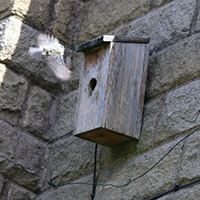 You may find that it takes a couple of years before birds start to use your nest box. Be patient! However, once birds have found a safe place for them to rear their young, they are likely to return each year.
You may find that it takes a couple of years before birds start to use your nest box. Be patient! However, once birds have found a safe place for them to rear their young, they are likely to return each year.
Once nesting season begins, hopefully you will see birds exploring the bird box and considering it for their nest. As the season goes on you will see adults bringing in bedding material and then, once the fledglings hatch, food for their brood.
The photo to the right shows a Blue Tit approaching a nesting box to feed fledglings.
Can I see inside the bird box?
It is possible to purchase nest box cameras to allow you to look at what is happening inside the bird box you have located in your garden (as shown in the image below). The RSPB sell these, as do various commercial providers. These can be a relatively costly investment and remember you may need to wait patiently for your box to become a home. However, they do allow you to watch the excitement of birds selecting the nesting box, building the nest, laying the eggs and the chicks hatching.
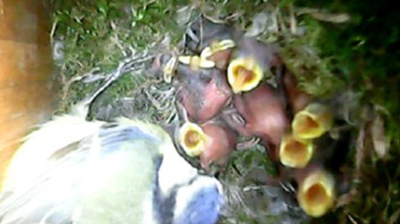 Blue Tit fledglings awaiting food within nesting box, viewed by a nest box camera.
Blue Tit fledglings awaiting food within nesting box, viewed by a nest box camera.



Rate and Review
Rate this article
Review this article
Log into OpenLearn to leave reviews and join in the conversation.
Article reviews